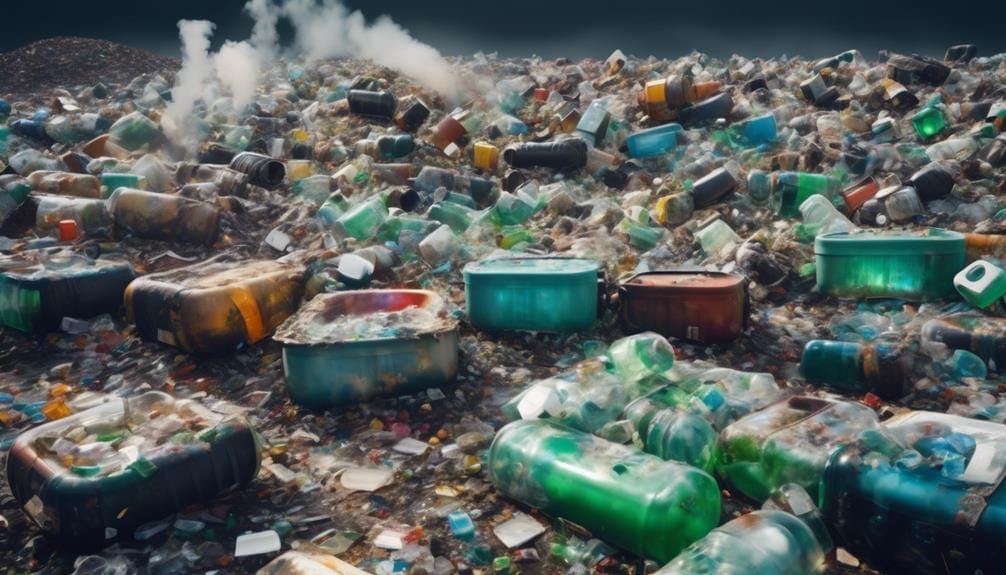Imagine a delicate ecosystem, teeming with life and vibrant colors, much like a breathtaking coral reef. Now, picture the impact that liquid glass epoxy could have on such an ecosystem.
As you delve into the discussion of the environmental impact of this material, you will uncover the potential consequences it may have on water, air, soil, wildlife, and waste generation.
But fear not, for there are sustainable alternatives and practices that can help mitigate these effects.
So, let's explore the intricate relationship between liquid glass epoxy and the environment, and discover how we can protect our precious natural world.
Key Takeaways
- Liquid glass epoxy used in glass fiber reinforced polymer composites can contribute to air and water pollution.
- Improper disposal of waste materials from production can harm the environment.
- Liquid glass epoxy can contaminate water bodies, disrupting ecosystems and harming aquatic life.
- Liquid glass epoxy production and application can contribute to air pollution.
Ecosystem Impact
Liquid glass epoxy, a type of epoxy resin, is widely used in various industries due to its excellent mechanical properties and high resistance to water absorption. However, it's essential to understand its environmental impact, particularly on ecosystems.
When liquid glass epoxy is used in the production of glass fiber reinforced polymer composites, it can potentially lead to environmental issues. The manufacturing process of epoxy resin involves the use of chemicals and solvents, which may contribute to air and water pollution if not properly managed. Additionally, the disposal of waste materials from the production process can pose a risk to the environment if not handled correctly.
Furthermore, the durability of glass fiber reinforced polymer composites, which contain liquid glass epoxy, can impact ecosystems. These composites are commonly used in construction and industrial applications, and their long lifespan means that they may persist in the environment for an extended period. If not properly managed or recycled, these materials could accumulate in ecosystems, potentially causing harm to wildlife and disrupting the natural balance.
Therefore, it's crucial for industries utilizing liquid glass epoxy and glass fiber reinforced polymer composites to implement sustainable waste management practices and promote recycling. By doing so, the potential environmental impact can be minimized, ensuring the long-term health and stability of ecosystems.
Water Pollution
Water pollution is a significant concern when discussing the environmental impact of liquid glass epoxy.
The use of harmful chemicals in the production and application of this material can lead to the contamination of water bodies.
This contamination can disrupt ecosystems and have detrimental effects on aquatic life and human health.
Harmful Chemicals in Water
Harmful chemicals present in water pose significant health risks to both humans and wildlife due to their potential for contamination of water sources. Industrial chemicals, such as solvents and toxic metals, can seep into water bodies, causing water pollution and long-term environmental damage. Agricultural runoff, containing fertilizers and pesticides, can also contribute to water pollution and disrupt aquatic ecosystems. Improper disposal of pharmaceuticals and personal care products can introduce harmful chemicals into water, impacting aquatic life and potentially entering the food chain. Additionally, microplastics originating from various sources can introduce harmful chemicals into water, posing ecological risks. It is important to understand the impact of these chemicals on water quality and take measures to prevent their contamination.
| Chemicals | Sources |
|---|---|
| Heavy metals | Industrial waste, mining, and natural weathering |
| Pesticides | Agricultural runoff and improper disposal |
| Solvents | Industrial processes and improper disposal |
| Fertilizers | Agricultural runoff |
| Microplastics | Synthetic clothing, plastic waste, and degradation |
Ecosystem Disruption
The presence of harmful chemicals in water can lead to ecosystem disruption, specifically water pollution, which can have detrimental effects on the environment.
When it comes to the environmental impact of liquid glass epoxy, it's important to consider its potential contribution to water pollution. Liquid glass epoxy is commonly used in the manufacturing of glass-fiber reinforced polymer (GFRP) composite materials.
If these materials aren't properly managed and disposed of, they can end up in water sources, such as seawater. In a warm environment, the liquid glass epoxy can degrade and release harmful chemicals into the water, causing pollution.
This pollution can disrupt the balance of the ecosystem, affecting aquatic life and overall ecosystem health. Proper waste management and disposal practices should be implemented to minimize the environmental impact of liquid glass epoxy and prevent water pollution.
Air Pollution

Air pollution, caused by the release of harmful substances into the atmosphere, poses significant threats to human health and the environment. When considering the environmental impact of liquid glass epoxy, it's important to evaluate its potential contribution to air pollution. Although liquid glass epoxy itself may not directly emit pollutants, the manufacturing and application processes can result in the release of harmful substances.
Here are some key points to consider regarding the relationship between liquid glass epoxy and air pollution:
- Emission sources: Air pollution can be generated during the production of liquid glass epoxy, particularly from the energy-intensive processes involved. Additionally, the application of liquid glass epoxy can release volatile organic compounds (VOCs) into the air, contributing to air pollution.
- Health risks: Exposure to air pollution, including VOCs, can have detrimental effects on human health, leading to respiratory diseases and other health issues.
- Environmental consequences: Air pollution from liquid glass epoxy production and application can have negative impacts on the environment, such as contributing to the formation of smog, acid rain, and the deterioration of air quality.
- Mitigation measures: To minimize the environmental impact of liquid glass epoxy, it's crucial to implement appropriate emission control measures during production and application, such as using cleaner energy sources and adopting proper ventilation systems to reduce VOC emissions.
Understanding the potential air pollution implications of liquid glass epoxy is essential for developing strategies to mitigate its environmental impact and ensure the protection of human health and the environment.
Soil Contamination
Soil degradation and pollution effects are significant concerns when it comes to soil contamination caused by liquid glass epoxy.
The introduction of liquid glass epoxy into the soil can lead to changes in soil structure and composition, affecting its ability to support plant growth and sustain a healthy ecosystem.
Additionally, the presence of harmful substances in liquid glass epoxy can further contribute to soil pollution, potentially impacting water quality and overall environmental health.
Soil Degradation
Pollutants and harmful substances in the environment can deteriorate the quality of soil, negatively impacting its fertility and posing risks to human health. Soil degradation, also known as soil contamination, occurs when contaminants such as heavy metals, chemicals, and industrial waste are present in the soil. This can lead to reduced agricultural productivity and pose risks to human health through the consumption of contaminated crops.
Common contributors to soil degradation include industrial activities, improper waste disposal, and the use of agrochemicals. To mitigate the environmental impact of soil degradation, remediation techniques such as phytoremediation and soil washing can be employed. These methods aim to remove or break down the contaminants in the soil, restoring its fertility and ensuring the health and safety of both the environment and humans.
Pollution Effects
The detrimental effects of soil contamination caused by pollutants from foundry production are a significant concern for environmental and human health.
When it comes to the pollution effects of liquid glass epoxy, it's important to consider its environmental impact. Liquid glass epoxy, also known as epoxy resin, is commonly used as a binder in glass-fiber reinforced composites.
During the production and application of these composites, pollutants can be released into the environment, potentially leading to soil contamination. The disposal of solid waste generated during the manufacturing process, such as leftover resin and fiberglass scraps, can contribute to soil pollution if not properly managed.
Therefore, it's crucial to implement effective waste management strategies, including waste prevention, minimization, and recycling, to mitigate soil contamination caused by the pollution effects of liquid glass epoxy.
Wildlife and Marine Life Effects

Liquid glass epoxy has been found to have significant adverse effects on wildlife and marine life, posing a threat to various species and altering fragile ecosystems. The environmental impact of liquid glass epoxy on wildlife and marine life is a concerning issue that requires attention. Here are some key effects that have been observed:
- Decomposition process: Liquid glass epoxy can release harmful chemicals during its decomposition process. These chemicals can contaminate aquatic environments and have detrimental effects on marine organisms.
- Chemical release: The epoxy can release harmful chemicals into the water, which can have adverse effects on both wildlife and marine life. This can lead to health issues and even fatality for the affected organisms.
- Ingestion and entanglement: Wildlife and marine life can be negatively impacted by ingesting or becoming entangled in liquid glass epoxy waste. This can cause harm, impair their ability to survive, and disrupt the natural balance of the ecosystem.
- Ecosystem disruption: The introduction of liquid glass epoxy into marine ecosystems can disrupt the natural balance and threaten the survival of various species. This can have cascading effects on the entire ecosystem, affecting the biodiversity and stability of marine habitats.
To mitigate the detrimental impact of liquid glass epoxy on wildlife and marine life, it's crucial to implement proper disposal and recycling methods. This will help minimize the release of harmful chemicals and reduce the risk to vulnerable species and ecosystems.
Human Health Risks
Liquid glass epoxy poses potential health hazards and risks to human beings. The emissions released during its production can result in respiratory problems and other health issues.
Direct contact with liquid glass epoxy without proper protective equipment can also cause skin irritation and allergic reactions.
Health Hazards
When using liquid glass epoxy, it's important to consider the potential health hazards and risks associated with its use. Here are some key points to be aware of:
- Inhalation: Breathing in the vapors or dust particles from liquid glass epoxy can irritate the respiratory system and may cause symptoms such as coughing, wheezing, and shortness of breath.
- Skin contact: Direct contact with liquid epoxy can cause skin irritation, redness, and allergic reactions. Prolonged or repeated exposure may lead to dermatitis.
- Eye contact: Accidental splashes or contact with liquid epoxy can result in eye irritation and potential damage. Protective eyewear should always be worn when handling the product.
- Ingestion: Swallowing liquid glass epoxy can cause nausea, vomiting, and gastrointestinal distress. It's crucial to avoid ingestion and seek medical attention if it occurs.
To minimize the health risks associated with liquid glass epoxy, always follow safety precautions, such as wearing protective clothing, working in a well-ventilated area, and using appropriate personal protective equipment.
Potential Risks
To fully understand the potential risks associated with liquid glass epoxy, it's important to consider the human health risks that may arise from its use.
The environmental durability of liquid glass epoxy can lead to long-term exposure to its components, increasing the likelihood of adverse health effects. One potential risk is accelerated aging, as prolonged exposure to liquid glass epoxy may cause skin irritation and respiratory issues.
Moisture absorption is another concern, as it can lead to the growth of mold and fungi, which can trigger allergies and respiratory problems. Furthermore, the environmental effects of liquid glass epoxy, such as the release of harmful gases during production and the disposal of waste, can pose health risks to workers and nearby communities.
Therefore, it's crucial to take precautions and implement proper safety measures when handling and using liquid glass epoxy to minimize potential health risks.
Waste Generation and Disposal

Waste generation and disposal in foundry production involves significant amounts of dust, harmful gases, and solid industrial waste. This process poses several challenges for the industry, particularly in the disposal of solid foundry waste.
Here are some key points to consider regarding waste generation and disposal in the foundry industry:
- Solid foundry waste, such as spent molding and core mixtures, presents a serious problem for foundries. Disposing of this waste can be costly and time-consuming.
- Transportation and burial of waste to storage areas incur significant material costs for foundry enterprises. This further adds to the environmental impact of waste disposal.
- Waste heaps from foundry waste can have detrimental effects on the soil. They can alter the structure, physicochemical properties, and mechanical composition of the soil. Therefore, strategic waste management is essential in order to minimize these negative impacts.
- Foundries must prioritize waste prevention, minimization, and recycling as part of their waste management strategy. This approach helps to reduce the overall environmental impact of waste generation and disposal in the industry.
Energy Consumption
The environmental impact of waste generation and disposal in the foundry industry extends beyond the challenges of waste management, as it also encompasses the significant energy consumption involved in the production process. Foundry production involves a high material use coefficient, ranging from 70-90%. Molds used in the industry can weigh from several grams to over 100 tons, and different molding technologies are employed, including expendable green sand molds and liquid glass mixture molds.
The production stages in the foundry industry emit significant dust, harmful gases, and solid industrial waste, resulting in environmental problems. To mitigate these issues, recycling and reusing foundry waste can help reduce environmental risk and minimize the transportation and burial costs associated with waste management.
In addition to waste generation and disposal, the production of liquid glass epoxy also involves substantial energy consumption. The foundry industry relies on energy-intensive processes to melt metals and create molds. This energy consumption contributes to greenhouse gas emissions and further exacerbates the environmental impact of the industry. As the demand for liquid glass epoxy continues to grow, it becomes essential to explore energy-efficient manufacturing processes and renewable energy sources to minimize the environmental impact.
Rational use of raw materials and material resources is crucial in modern conditions. By recycling industrial waste and implementing energy-efficient practices, the foundry industry can reduce production costs and improve environmental conditions. It's imperative for manufacturers to prioritize sustainable practices and invest in technologies that minimize energy consumption throughout the production process. Only through these measures can the environmental impact of liquid glass epoxy and the foundry industry as a whole be effectively mitigated.
Carbon Footprint

The carbon footprint of liquid glass epoxy production is a significant aspect to consider when assessing its environmental impact. Liquid glass epoxy, although known for its durability and versatility, has a carbon footprint that can contribute to climate change and environmental degradation.
Here are some key points to understand about the carbon footprint of liquid glass epoxy production:
- Liquid glass epoxy production involves the use of fossil fuels and energy-intensive processes, leading to the release of greenhouse gases into the atmosphere.
- The epoxy matrix used in liquid glass epoxy typically contains petroleum-based components, which have a high carbon content and contribute to carbon emissions.
- The manufacturing process of liquid glass epoxy requires heating and curing, which often relies on non-renewable energy sources, further increasing its carbon footprint.
- The disposal of liquid glass epoxy can also be an environmental concern, as it may release harmful substances into the environment when not disposed of properly.
Considering the environmental impact of liquid glass epoxy, it's essential to explore alternative materials and production methods that are more environmentally friendly. Research and development efforts should focus on developing epoxy matrices with lower carbon content and exploring more sustainable ways to produce and dispose of liquid glass epoxy.
Sustainable Alternatives
To explore sustainable alternatives to liquid glass epoxy, consider investigating the use of recycled epoxy resin and composites to reduce environmental impact. By utilizing recycled epoxy resin, you can minimize the amount of waste generated during the production process. This not only helps to reduce the carbon footprint but also conserves valuable resources. Additionally, incorporating recycled materials into composites can further enhance their environmental sustainability. By using recycled carbon fibers, for example, you can reduce the reliance on virgin materials and decrease the overall energy consumption in the manufacturing process.
Another avenue to explore is the use of eco-friendly epoxy alternatives made from bio-based materials. These materials are derived from renewable sources, such as plant-based oils or biodegradable polymers. By utilizing bio-based epoxy resin, you can significantly reduce the environmental impact associated with traditional epoxy production. Furthermore, the development of biodegradable epoxy resins holds promise for sustainable applications. These resins have the ability to break down naturally over time, reducing their persistence in the environment.
In addition to exploring alternative epoxy resins, evaluating the use of natural fibers and fillers as alternatives to glass fibers in epoxy composites can also contribute to sustainability. Natural fibers, such as flax, hemp, or bamboo, have the advantage of being renewable and biodegradable. They can offer comparable mechanical properties to glass fibers while reducing the environmental impact associated with their production and disposal.
Lastly, promoting the adoption of novel green chemistry approaches for epoxy resin production is crucial. These approaches aim to minimize the use of hazardous substances, reduce energy consumption, and optimize the efficiency of the manufacturing process. By implementing greener production methods, the environmental impact of epoxy resin can be significantly reduced.
Frequently Asked Questions
Does Glass Have a Negative Impact on the Environment?
Glass, when not properly managed, can have a negative impact on the environment. Recycling options, energy consumption, waste management, environmental regulations, carbon footprint, and sustainable alternatives are all factors that should be considered to minimize this impact.
What Is the Difference Between Liquid Glass and Epoxy Resin?
Liquid glass and epoxy resin differ in application methods, curing time, versatility in usage, durability, cost, and toxicity levels. Liquid glass provides a hard finish, while epoxy resin offers flexibility and impact resistance.
Conclusion
After examining the environmental impact of liquid glass epoxy, it's clear that sustainable practices are crucial in its production and disposal.
The emission of harmful gases, generation of waste, and potential pollution of ecosystems highlight the need for responsible waste management and recycling.
By adopting these practices, we can minimize the carbon footprint and mitigate the negative effects on wildlife, water, air, and soil.
It's imperative that we prioritize the use of sustainable alternatives to reduce the environmental impact of liquid glass epoxy.





